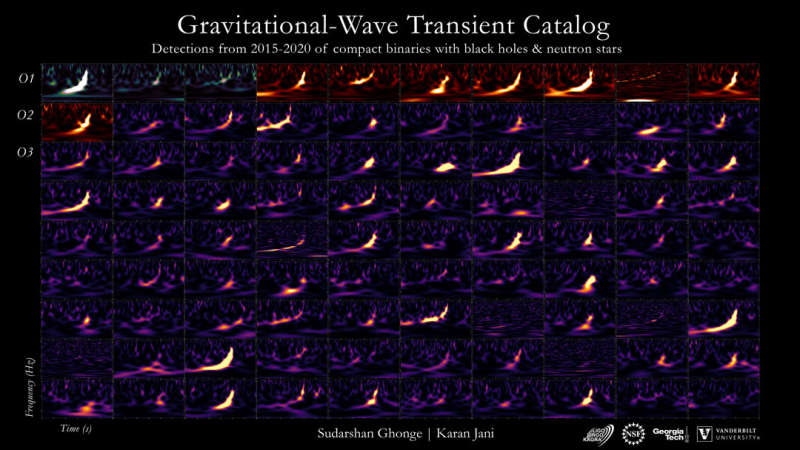Credit & Copyright: NSF,
LIGO,
VIRGO,
KAGRA,
Georgia Tech,
Vanderbilt U.;
Graphic :
Sudarshan Ghonge &
Karan Jani
Explanation:
Every time two massive
black holes collide,
a loud chirping sound is broadcast out into the universe in
gravitational waves.
Humanity has only had the technology to hear
these unusual chirps for the past seven years,
but since then we have heard about 90 -- during the first three observing runs.
Featured above are the spectrograms
-- plots of gravitational-wave frequency versus time --
of these 90 as detected by the giant detectors of
LIGO (in the
USA),
VIRGO
(in Europe), and
KAGRA
(in Japan).
The more energy received on
Earth
from a collision, the
brighter it appears on the graphic.
Among many science firsts, these
gravitational-radiation chirps
are giving humanity an unprecedented
inventory of black holes and neutron stars, and a new way to
measure the expansion rate of our universe.
A fourth gravitational wave observing run with
increased sensitivity is currently planned to begin in 2022 December.
1999 2000 2001 2002 2003 2004 2005 2006 2007 2008 2009 2010 2011 2012 2013 2014 2015 2016 2017 2018 2019 2020 2021 2022 2023 2024 2025 |
Январь Февраль Март Апрель Май Июнь Июль Август Сентябрь Октябрь Ноябрь Декабрь |
NASA Web Site Statements, Warnings, and Disclaimers
NASA Official: Jay Norris. Specific rights apply.
A service of: LHEA at NASA / GSFC
& Michigan Tech. U.
|
Публикации с ключевыми словами:
gravitational radiation - гравитационное излучение
Публикации со словами: gravitational radiation - гравитационное излучение | |
См. также:
Все публикации на ту же тему >> | |
